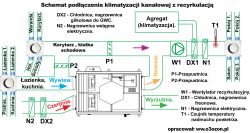Hello,
Dear friends, I'm "hot" for recuperation with cooling function.
After going through a few fitters, a few designers and a few companies selling reku, I noticed a gigantic crossover of opinions on this subject.
The usable area of the house is about 130 m2, the total area is about 160 m2, it is a two-story middle segment.
The plan was to install a recuperator with a cooling function. It's not about making the house cool, but about some control over the temperature on hot days so that the house does not gain much temperature and feel a pleasant coolness inside.
And so ... we settled on the LMF Klima recuperator - HRH 5 version with a freon module for additional heating or cooling. And the steps began...
One says that such an installation will reduce the temperature in the house by maybe 5 ºC, another says that it can reduce the temperature, but then we have to install an installation with 2x higher flows to better receive heat (but then the concept of a heat exchanger in a recuperator or recovery loses its value because the exchanger cools down too quickly or heats up from the outside air).
Another theory is to install a recuperator with a standard flow but have a larger thrust than in an ordinary recuperator and then put larger diffusers to reduce any noise associated with increasing the thrust in the recuperator on the pipes and then leave the standard piping. Of course, everything on spiro insulated pipes (or at least the air intake to the house).
I know only 2 companies (COMPANIES) that have this device and they all praise that it works for them and fits and works well, but the recuperator works all the time at high draft (if not maximum), although one of the companies explains this by the fact that they just have it on the workshop part and want to get rid of dust.
What is your opinion?
Most installers say "sir, this will give you maybe 5 degrees C difference in temperature in the house and it will heat up through the windows more than it cools down".
Any suggestions are worth gold...
Links to recommended equipment, LMF Climate - HRH 5 and another link .
Regards
Added after 5 [minutes]:
PS: Most recuperative companies that install reku for the home do not want to install it at all as it is not a popular company like zechnder or tessra.
Dear friends, I'm "hot" for recuperation with cooling function.
After going through a few fitters, a few designers and a few companies selling reku, I noticed a gigantic crossover of opinions on this subject.
The usable area of the house is about 130 m2, the total area is about 160 m2, it is a two-story middle segment.
The plan was to install a recuperator with a cooling function. It's not about making the house cool, but about some control over the temperature on hot days so that the house does not gain much temperature and feel a pleasant coolness inside.
And so ... we settled on the LMF Klima recuperator - HRH 5 version with a freon module for additional heating or cooling. And the steps began...
One says that such an installation will reduce the temperature in the house by maybe 5 ºC, another says that it can reduce the temperature, but then we have to install an installation with 2x higher flows to better receive heat (but then the concept of a heat exchanger in a recuperator or recovery loses its value because the exchanger cools down too quickly or heats up from the outside air).
Another theory is to install a recuperator with a standard flow but have a larger thrust than in an ordinary recuperator and then put larger diffusers to reduce any noise associated with increasing the thrust in the recuperator on the pipes and then leave the standard piping. Of course, everything on spiro insulated pipes (or at least the air intake to the house).
I know only 2 companies (COMPANIES) that have this device and they all praise that it works for them and fits and works well, but the recuperator works all the time at high draft (if not maximum), although one of the companies explains this by the fact that they just have it on the workshop part and want to get rid of dust.
What is your opinion?
Most installers say "sir, this will give you maybe 5 degrees C difference in temperature in the house and it will heat up through the windows more than it cools down".
Any suggestions are worth gold...
Links to recommended equipment, LMF Climate - HRH 5 and another link .
Regards
Added after 5 [minutes]:
PS: Most recuperative companies that install reku for the home do not want to install it at all as it is not a popular company like zechnder or tessra.



